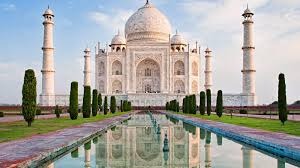Exploring the Majestic Taj Mahal: An Icon of Love and Architectural Brilliance
When one thinks of timeless symbols of love and architectural grandeur, the Taj Mahal inevitably comes to mind. Nestled on the banks of the Yamuna River in Agra, India, this iconic mausoleum is not just a marvel of design but a poignant testament to the enduring power of love.
A Love Story Etched in Marble
Commissioned in 1632 by the Mughal Emperor Shah Jahan in memory of his beloved wife Mumtaz Mahal, the Taj Mahal is a tribute that transcends time. Mumtaz Mahal, who passed away during childbirth, was deeply cherished by Shah Jahan. Her untimely death left him grief-stricken, and the Taj Mahal was conceived as a grand gesture to honor her memory and ensure her eternal rest.
The monument's name, "Taj Mahal," translates to "Crown of the Palace," reflecting both its majestic beauty and its place of prominence in Mughal history.
Architectural Splendor: A Marvel of Mughal Design
The Taj Mahal is celebrated for its architectural brilliance and exquisite craftsmanship. Its design is a masterful blend of Persian, Islamic, and Indian architectural styles. The central dome, which rises to a height of 73 meters (240 feet), is surrounded by four minarets that accentuate its grandeur and symmetry. The white marble used in its construction, sourced from Makrana in Rajasthan, is adorned with intricate inlay work of semi-precious stones, creating stunning floral and geometric patterns.
One of the most fascinating aspects of the Taj Mahal is its optical illusion. Depending on the time of day and the angle from which it is viewed, the monument changes color, ranging from soft pinks in the morning to milky white in the evening and golden hues under the moonlight. This dynamic interplay of light and shadow adds to the mystique and allure of the Taj Mahal.
Gardens and Symmetry: A Haven of Tranquility
The Taj Mahal is set within a sprawling garden, known as the Charbagh, which is divided into four parts by water channels, symbolizing paradise on Earth. The symmetrical layout of the garden, with its reflecting pools and lush greenery, enhances the serene and harmonious atmosphere of the complex. The well-manicured lawns and the sound of running water create a tranquil setting that complements the monument's grandeur.
Cultural and Historical Significance
Beyond its architectural splendor, the Taj Mahal holds immense cultural and historical significance. It stands as a symbol of the rich Mughal heritage and represents a high point in the development of Mughal architecture. The monument's design and the craftsmanship involved reflect the advanced technological and artistic skills of the time.
In 1983, the Taj Mahal was designated a UNESCO World Heritage Site, recognized for its cultural significance and outstanding universal value. It continues to attract millions of visitors from around the globe, who come to witness its breathtaking beauty and to experience the poignant story behind its creation.
Preservation and Challenges
Despite its enduring beauty, the Taj Mahal faces challenges related to preservation. Issues such as pollution, water damage, and the wear and tear from constant tourism pose risks to its structural integrity. The Indian government, along with various conservationists, has undertaken numerous measures to address these concerns and ensure that the monument remains a lasting legacy for future generations.
Visiting the Taj Mahal: A Journey Through History and Romance
A visit to the Taj Mahal is more than just a sightseeing experience; it is a journey through history, romance, and architectural innovation. As you walk through the grand entrance and catch your first glimpse of the majestic white marble dome, you can't help but feel a sense of awe and wonder. The intricate details of the monument, the serene garden, and the story of Shah Jahan and Mumtaz Mahal combine to create a deeply moving experience.
In conclusion, the Taj Mahal is not merely a monument; it is an embodiment of love, an architectural marvel, and a cultural treasure. Its timeless beauty continues to inspire and captivate all who have the privilege of experiencing its splendor. Whether you are a history enthusiast, an architecture aficionado, or simply a romantic soul, the Taj Mahal offers a unique and unforgettable glimpse into a bygone era of grandeur and devotion.



